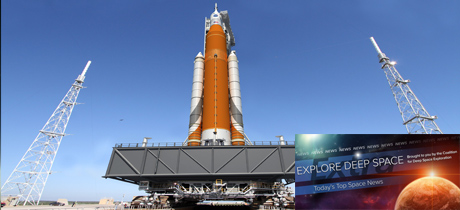In Today’s Deep Space Extra… The Block 1 version of NASA’s Space Launch System (SLS) may kickoff missions of the powerful rocket with multiple launches and payloads. NASA taking a second fast paced look at its lunar lander options for mid to large payloads.
Human Space Exploration
NASA adding more SLS Block 1 launches to manifest
Space News (7/10): Based on discussions by NASA and industry personnel at this week’s American Institute of Aeronautics and Astronautics’ Propulsion and Energy Forum in Cincinnati, the Block 1 version of NASA Space Launch System (SLS) rocket is likely to launch three times prior to the first flight of the Block 1B upgrade that was originally to boost the first Orion capsule with astronauts. Initially, the Block 1B was to require a near three year modification of the Mobile Launcher (ML) on hand for the first Block 1 mission that is to send an uncrewed Orion capsule around the Moon and back to Earth.
NASA assessing options to speed up mid-to-large lunar landers
Spacepolicyonline.com (7/10): NASA Administrator Jim Bridenstine’s staff is taking an accelerated look at the agency’s options for developing mid to large classes of lunar landers with commercial partners. Mid to large have been time lined for the post-2024 time frame to enable a human return to the lunar surface by the end of the 2020s. The assessment is to take a month.
Kavandi still waiting on potential NASA deputy administrator nomination
Space News (7/10): Janet Kavandi, former NASA astronaut and current director of NASA’s Glenn Research Center, was mentioned recently by new NASA Administrator Jim Bridenstine as his choice for agency deputy administrator, a post that like his requires a White House nomination and U.S. Senate confirmation. At an AIAA gathering this week in Cincinnati, Kavandi said she is unaware of any development on the matter but she feels honored to be considered.
Space Science
Europe’s ice-watching satellite dodges space junk in orbit
Space.com (7/10): The European Space Agency’s Earth orbiting Cryo Sat-2 spacecraft, which monitors changes in glacier ice, was maneuvered earlier this week to avoid the approach of a potential impact with space debris. It wasn’t a first, and ESA is hopeful it can return Cyro-Sat-2 to its normal orbital trajectory on Thursday.
Other News
‘Peanuts’ and NASA are collaborating again five decades after Snoopy’s Moon mission
Washington Post (7/10): NASA is again embracing Snoopy, the Peanuts canine cartoon character and aviation enthusiast through a Space Act Agreement with Peanuts Worldwide. As he did during NASA’s Apollo era, Snoopy will help to promote enthusiasm for future space exploration through STEM education and safety initiatives.
Energomash raises alarm over U.S. ban on Russian rocket engines
Coalition Members in the News – Northrop Grumman, United Launch Alliance
Space News (7/10): In another financial blow to Russia’s space program, exports to the U.S. of the RD-180 and RD-181 rocket engines manufactured by Energomash will soon come to an end. The RD-180 has powered the United Launch Alliance (ULA) Atlas V and the RD-181 has powered Northrop Grumman Innovation Services’ Antares. With restrictions on sales after December 31, 2022 and factoring in production time lines, purchases are already falling off.
Commercial Chinese companies set sights on methalox rockets, first orbital launches
SpaceNews.com (7/10): One of China’s emerging commercial launch companies says it has designed a methane- and liquid-oxygen-powered rocket it aims to test launch in 2020. Beijing-based Landspace is developing the Zhuque-2 (ZQ-2) rocket with the goal of completing ground testing in 2019 ahead of debuting the launch vehicle the following year.
Aerospace startup Rocket Lab says it’s going to build a second launch site in the U.S.
The Verge (7/10): U.S. startup Rocket Lab intends to establish a second launch site for its small satellite launch vehicles. The first one, in New Zealand, is to be joined by one in the United States. Candidate sites include Cape Canaveral, Florida, Vandenberg Air Force Base in California, NASA’s Wallops Flight Facility in Virginia and the Pacific Spaceport Complex in southern Alaska. With a final decision on a site this year, Rocket Lab says it could be launching from the new site next year.
The race to get tourists to suborbital space is heating up
Wired (7/10): A look at the latest prospects for passenger spaceflight, starting with suborbital flights by Virgin Galactic and Blue Origin. Bottom line: All have more test flights in front of them before they board passengers, including those who expect to fly as scientific researchers.

